English - writing
Writing
How we approach the teaching of our writing curriculum
Our writing curriculum follows the objectives of the National Curriculum. We use high quality texts through the Devon Education Services BookWrites Writing sequences with a ‘Talk for Writing’ approach as a basis for the delivery of Literacy throughout the school. This follows three distinct stages of: Learning About the Text, Practising Writing, and Independent Writing. We use these texts to generate ‘buzz and excitement’ in lessons, through learning the text and its structure, practising the text and then independently applying the themes and knowledge within the chosen text. We aim to develop grammar and punctuation knowledge and understanding so children can use and apply a greater range of skills across the wider curriculum; explore the writing structure and features of different genres and identify the purpose and audience. Children plan and write an initial piece of writing with a clear context and purpose before evaluating the effectiveness of writing by editing and redrafting. Writing is seen as a crafting process. We believe it is highly important to give children feedback on their writing that is rich and meaningful so that they are aware of their strengths and those areas that they need to be focussing on to further improve the quality of their writing.
Writer's Toolkit
Prior to delivering a writing sequence and across the 'Learning about the text' phase of the sequence, we aim to create a Writer’s Toolkit. Initially, we do this as teachers to familiarise ourselves fully with the text, and then we create a similar chart with the pupils. This will be used to formulate the success criteria for the unit outcome.
There are three main purposes:
- To enable us to engage more deeply with the text
- To create a chart with the pupils that they can use to support their writing
- To use as a basis for discussion when evaluating the effectiveness of the writing.
A toolkit consists of four boxes. The first is our ‘Purpose and Reader’, the second is ‘Effects on the reader?’. The third box ‘Ingredients’, contains examples of the devices used by the author so that we do not have to go back through the book to find them. The fourth box collects 'Vocabulary' examples.
We construct a version of this toolkit with the class as we move through the ‘Learning about the text’ phase. Each activity in this part of the sequence will reveal something about the text such as a response to a part of it and how the response was created. During the ‘Practising Writing’ and 'Independent Writing' phases, the toolkit will be regularly referred back to in order to support pupils with their writing.
'Learning about the text' Phase
During this stage, children are immersed in the text, familiarising themselves with the language and features of the genre. This is where pupils often learn by heart a section of the text or the whole of the text through key events.
A variety of activities are used in the 'Learning about the text' phase of the unit and include the following
- Reading for Meaning activities
- Oracy activities
- Role play and storytelling
- Vocabulary games
- Understanding key vocabulary
- Story and text mapping
- Exploring common features of the genre/text type
The 'Practising Writing' Phase
This is the phase in the sequence where, working as a class, we collect ideas to write and recreate elements of the core text in our own writing and practise using these skills in context. Once the children are familiar with the text, they are taught the key skills for that unit of writing. Planning identifies the grammar skills that will be taught during this phase. As they unpick the writing process to prepare them for independent writing, the Writer's Toolkit is referred back to and developed.
The 'Practising Writing' phase includes a range of activities:
- Grammar lessons linked to the outcome of the final write
- Punctuation needed to control the writing and impact upon the reader
- Oracy to rehearse sentence structures
- Paired writing activities
- Shared and modelled writing
- Development of handwriting
Through this phase, teachers model the collection of ideas and how to organise them into coherent plans through the use of story maps, boxing up grids, or spider graphs, depending upon both the age of the children, and what is the most purposeful for the given text.
A model plan is produced by the class teacher, which demonstrates how the original text has been innovated and changed to create an alternative version.
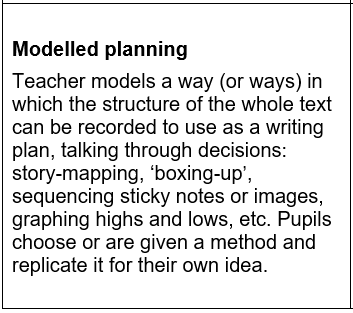
A model text is then produced, often over a number of days depending upon the year group. The key focus here is upon quality, rather than quantity. The Writer's Toolkit will be referred to frequently during this phase to encourage pupils to use the ideas collected on the toolkit through analysis of the text type. Although the teacher and the class will all be writing about very similar content, it is important that pupils do this in their own way. This practising writing helps them to apply what they have learnt in their final independent write.
Practising writing could be undertaken through a number of approaches as outlined below:
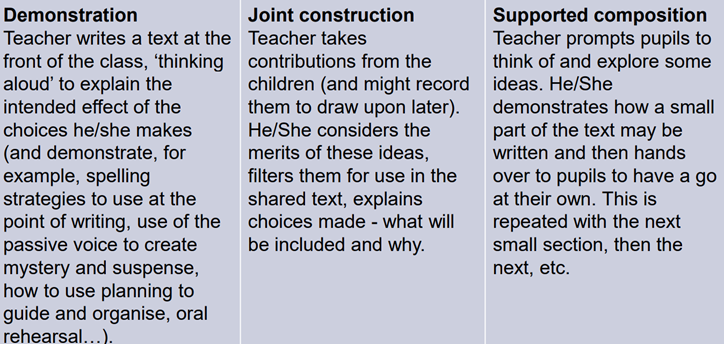
Another key feature of this part of the sequence is a focus on editing and improving writing so that pupils really explore applying the ideas taught to their writing. Teachers will follow the school’s editing policy.
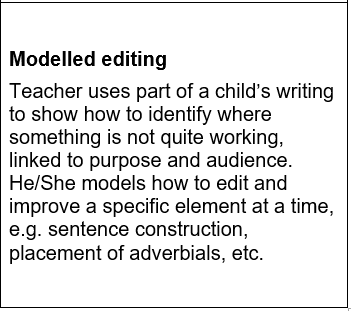
The 'Independent Writing' Phase
Now that the children have developed these skills, they are equipped to be able to transfer them into an independent piece of writing to demonstrate their newly learned knowledge of the language features, grammar skills and style of writing they have been working on.
Children are given opportunities to plan their invented writing and explore sentence structures through the boxing up process or modifying story/text maps. Boxing up grids, or similar (depending on the text type), will be used to support the planning process. These will outline the structure of the original text and the modelled class version to support the children in developing their own version of the text for independent writing.
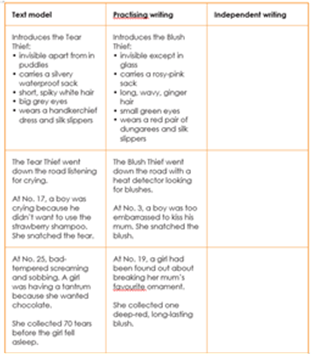

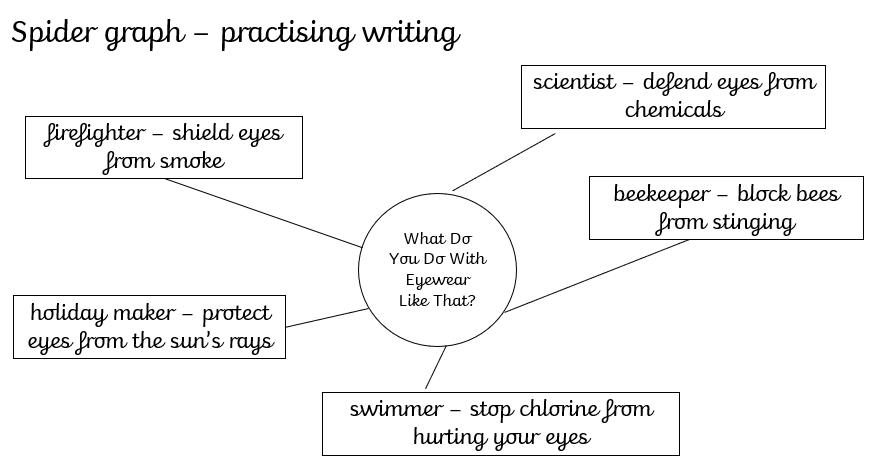
The children have access to the Writer’s Toolkit as a guide for their independent work and to remind them of the key features that they need to evidence.
Children edit their own work prior to their final independent draft. (The expectation for the writing is that is independent.) Children will not produce final drafts for all pieces of writing - they will only be for those that are going to be published with a purpose. The length of task is planned to reflect accuracy, rather than quantity; children need to write enough to show cohesion across paragraphs in upper Key Stage 2, but younger children would be expected to maintain accuracy across a single paragraph or a series of sentences. As they write, children are encouraged to follow their plan and use their toolkit checklist. Teachers and TAs encourage children to draw upon models and sentence structures to show what they can do. Independent writing is assessed by teachers against the National Curriculum objectives. Across the year, a range of evidence will be collected in order to form an attainment judgement for each pupil.
Writing walls
At Austin Farm Academy we have a consistent approach to supporting the writing process in classrooms. Writing walls are structured around the 3 key phases of the teaching sequences, Learning about the text, Practising Writing, and Independent Writing. Each wall contains a Writer's Toolkit for the current text being used to support the writing sequence. The purpose of the writing wall is for it to be a teaching tool that is developed and added to throughout the sequence.
